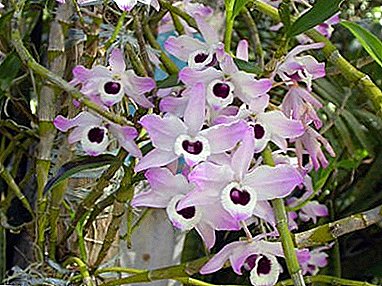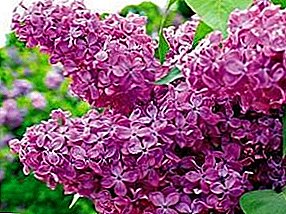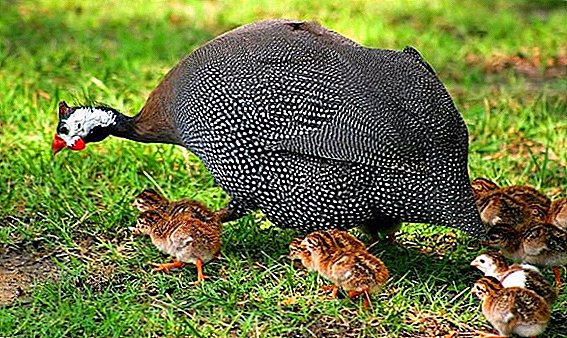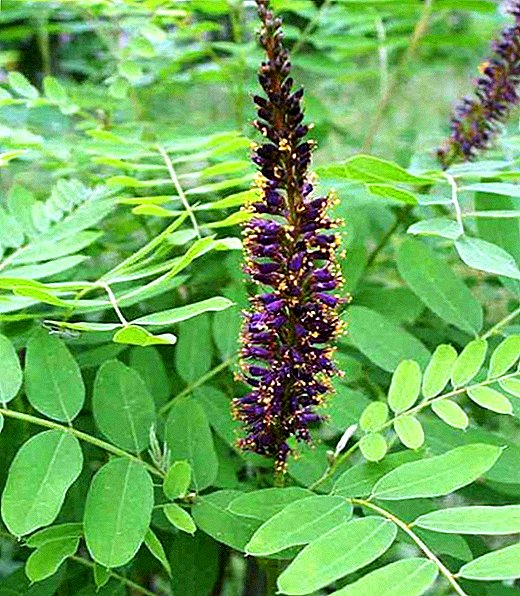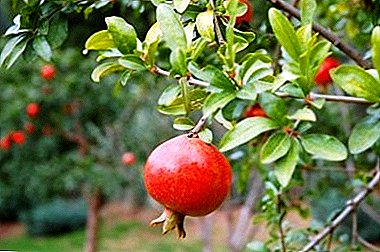
Pomegranate among growers is known as the easiest to care fruit plant.
What to do after purchase?
 As a rule, flowers in stores are sold in little suitable pots - plastic and very small in size.
As a rule, flowers in stores are sold in little suitable pots - plastic and very small in size.
If you bought a flowering or fruiting pomegranate, and the plant clearly requires a larger pot, then you should not repot it, but restrict transshipment.
To do this, take a larger pot, put a small layer of expanded clay on the bottom, then a layer of soil.
Carefully remove the pomegranate from the store pot with a clod of earth. For this operation to be successful, the ground must be dry.
Put the plant in the center of the new pot, fill the void with earth and pour it abundantly.
Let's take a closer look at how to care for a houseplant.
Growing out of the bones at home
You can grow a homemade pomegranate from pomegranate seed.
To do this, carefully, trying not to damage the red shell, remove a few seeds from the ripe fruit. After washing, they are left in the air for a day so that they can dry out a little.
Put the grains in a well-moistened porous substrateconsisting of three approximately equal parts: peat, sand and earth. Under it in the pot should be a large layer of drainage. Grains are placed at a depth of about one centimeter.
To make it easier to germinate, the pot should be covered with polyethylene or a glass jar. Several times a day, such a mini-greenhouse needs to be removed so that the ground can be aired.
And when the grains germinate, releasing a pair of leaves, it can be removed altogether.
 A pot with planted seeds is sent to a warm place. It is desirable to fall on it direct sunlight.
A pot with planted seeds is sent to a warm place. It is desirable to fall on it direct sunlight.
Then the first shoots will appear within two weeks after planting. For about a month they will remain very fragile.
Only after this period can they be transplanted into "adult" pots.
Transfer
Young plants need an annual transplant. Adults grow much slower, they should change the pot as needed, no more than once every three years. This is done at the beginning of the vegetative period, at the end of February - the beginning of March.
Pomegranate feels good in shallow pots: its roots are located on the surface and do not go deep down. At the bottom of the layer poured claydite, add a little soil.
Then remove the plant from the old pot and thoroughly clean the roots from the ground. Then placed in the center of the new and covered with earth. The transplanted plant is abundantly watered.
Soil and soil
Garnet not exacting to the soil. For him, any suitable universal primer for home flowers. The plant will be grateful if sand is added to it, about a third of the volume of the whole earth.
Lighting
Indoor grenade extremely photophiloustherefore, when possible, it is grown on a sunny south window. But there on the hot summer days he may need shading: the plant does not tolerate direct sunlight.
Northern windows in a pomegranate room environment can be disastrous. Due to lack of light, the flower will refuse to bloom and bear fruit, will begin to shed its leaves.
Watering
WITH February to November pomegranate needs regular watering. A signal to the fact that the plant needs a new portion of water may be the drying of the soil at a depth of 2 cm.
After the pomegranate has faded, the frequency of watering is slightly increased. And when the plant throws off the leaves, reduce. In winter it is enough to water it alone. once in two months.
How does bloom?
 Pomegranate can start flowering in the first year of its life. Usually in May, bright red flowers form at the ends of all strong annual shoots.
Pomegranate can start flowering in the first year of its life. Usually in May, bright red flowers form at the ends of all strong annual shoots.
Each of them will live no more than three days, but the next one will immediately appear in its place. It can go on until September.
Interestingly, at the same time on the plant appear two types of flowers: female and male. The first - rounded, with long pestles.
Subsequently, the fruits will develop from them. The second - elongated, similar to lilies, have short pistils. These are barren flowers. And if the ultimate goal of pomegranate cultivation is a harvest, then their best immediately removeso that the plant does not spend its strength.
Pruning
For young plants pruning is a necessary procedure. They transfer its grenades completely painlessly, so that it can be produced twice a year: mandatory in the spring and, if desired, in the autumn. Removing with dry scissors or shears dry branches and overgrown shoots, it is possible to form a bush of any shape.
Important! If you wish, you can even try to grow bonsai from a pomegranate. To do this, the plant is left only one shoot, removing all the rest at the root. So it will be formed in the form of a small tree. At the same time continue to bloom and bear fruit.
When to wait for the harvest?
 Plants grown from seeds can bear fruit in the third year of their life.
Plants grown from seeds can bear fruit in the third year of their life.
However, these pomegranates will not be as tasty as the one from which the seed was once taken for planting.
In the store and on the market, the fruits of hybrid varieties of this plant are sold, which, when propagated in this way, do not convey their taste qualities.
How to grow in the garden?
Grenades grown from seeds or cuttings purchased in a nursery can be grown in open ground. They are planted in the sunniest place of the site and only when the soil is at a depth 10-12 cm warms up at least 12 degrees heat Soil pomegranate requires loose, well-drained.
For planting, dig a hole about 60 cm deep in the ground. Lay a layer of earth mixed with rotted manure at the bottom.
Seedlings are placed at a depth 5 - 10 cm, so more additional roots will begin to form. Land when landing is well pressed to avoid airspace, and plentifully watered.
In the future, pomegranate will not need frequent watering, this plant is resistant to drought. Once a week he will be quite enough. To keep moisture in the ground better, the soil around the plant is mulched every year.
Also, pomegranate is very grateful for organic fertilizers. In addition, the grenade will need pruning. The optimal form for it is bushy. To support it, usually the plant leaves five trunks. Shrubs are formed in spring or autumn, after harvest.
The plant will bloom for 2 - 3 years after planting. And in the fourth year it will be possible to enjoy the fruits.
Winter care
Pomegranate is a heat-loving plant, and it will not be easy for him to survive in open ground the winter of central Russia. It will take a number of activities in order not to lose the plant during frosts.
How to cover for the winter?
 As soon as the pomegranate fruits ripen, you will need to start preparing for the winter. First, the garnet is cut, removing all dried and fat branches. Around the middle of November, a grenade is being harbor. This can be done in two ways:
As soon as the pomegranate fruits ripen, you will need to start preparing for the winter. First, the garnet is cut, removing all dried and fat branches. Around the middle of November, a grenade is being harbor. This can be done in two ways:
Two wooden pegs are hammered around each bush. The plant is tilted and tied to the stakes. Top piled up the soil from between the rows.
Dry grass is placed on the trunk and covered with earth. A frame is placed above the plant, to which a covering material is attached, for example, spandbond, folded in several layers. On top of this structure additionally covered with cellophane.
Both of these methods will help the grenade not to freeze. The main thing - in the spring does not pull with the disclosure, otherwise the bark of the plant may grind. Usually in early April, the temperature is already set, at which the grenade will feel good without shelter.
Diseases and pests
Both at home and in the garden, pomegranates are waiting for the same diseases.
Gray rot
Plants are covered with gray mold. If this is detected, it should be immediately treated with special preparations.
Spider mite
The disease begins to appear on the leaves, which are covered with a white sticky film. You can treat it with tobacco infusion or use special products that are sold in stores.
In addition, sometimes the plant begins to be capricious, ceases to bloom and bear fruit. To this he has reasons to find.
Why sheds leaves?
Pomegranate leaves should be dropped soon after its fruits ripen. So he prepares for rest period. This is absolutely normal. But if this happens at another time, then the reason, most likely, is that it lacks light. It is necessary to rearrange or transplant the grenade to a better lit place.
Why dumping fruit?
If still immature or just fruit are falling off, it means that the grenade does not have enough vitality to feed them. In this case, you need to make fertilizer. And also to review the entire scheme of care for him: perhaps he is too cold or dark.
- kinds;
- harm and benefit of the fruit and its seeds.
Why does it bloom but does not bear fruit?
 In order for the fruit to start, pomegranate flowers are needed pollinate. For greater effect, it is better to plant several plants at once. Although on one pomegranate bush should grow two types of flowers.
In order for the fruit to start, pomegranate flowers are needed pollinate. For greater effect, it is better to plant several plants at once. Although on one pomegranate bush should grow two types of flowers.
Pollination can be carried out artificially. To do this, take a soft brush and collect it pollen on a male flower with a short pistil.
Then this brush is carried out on the female flower, with a long pestle. After that, it should be the fruit.
So, grow a pomegranate at home or in the garden is not so difficult. The plant will thank for the simple care abundant flowering and tasty fruits.



